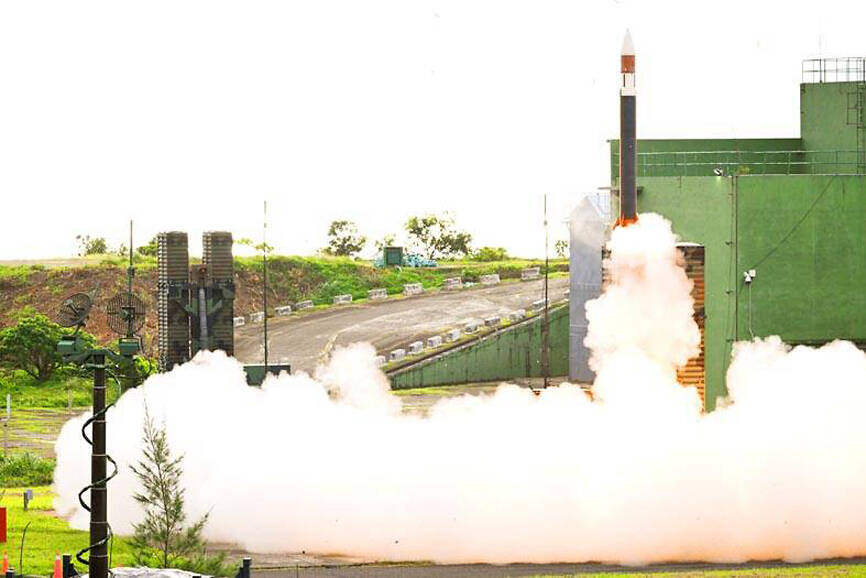Mass production of Tien Kung IV (Sky Bow IV) missiles is expected to start next year, with plans to order 122 pods, the Ministry of National Defense’s (MND) latest list of regulated military material showed.
The document said that the armed forces would obtain 46 pods of the air defense missiles next year and 76 pods the year after that.
The Tien Kung IV is designed to intercept cruise missiles and ballistic missiles to an altitude of 70km, compared with the 60km maximum altitude achieved by the Missile Segment Enhancement variant of PAC-3 systems.

Photo: Chen Yi-kuan, Taipei Times
A defense source said yesterday that the number of pods the military is procuring would be identical to the total number of missiles it plans to order, as each pod contains one projectile.
The ministry is expected to publish detailed information concerning Tien Kung IV missile acquisitions either as part of the government’s regular budget or a special program under the Executive Yuan by the middle of this month, they added.
The Tien Kung IV is one of the two products of the Chungshan Institute of Science and Technology’s Chiang Kung (強弓, Strong Bow) program to improve the range and performance of Tien Kung III missiles, a source said in May on condition of anonymity.
The other, an unnamed product of the Chiang Kung program, is rumored to be composed of an “A” air defense variant offering comparable performance to the US Terminal High Altitude Area Defense systems, and a “B” variant for long-range strikes against ground targets.
NEW VEHICLES
Separately, the document listed 20 types of equipment intended for use in a new model of eight-wheeled armored fighting vehicle armed with a 105mm rifled gun and its derivatives.
This unnamed combat vehicle — which reportedly passed an initial operational capability assessment in late 2023 — was developed from Taiwan’s indigenously developed CM-33 Clouded Leopard family of vehicles.
Research, development and testing of the experimental vehicle are anticipated to be completed by June next year, and 500 orders would be placed in batches starting in 2028, the document said.
Three of the 20 equipment types are to be interoperable in vehicles armed with the 105mm gun and dedicated reconnaissance vehicles that share a common chassis undergoing early development, the list said.
The combat vehicle would be armed with a coaxial 7.62mm machine gun and a 12.7mm coaxial heavy machine gun in a remote weapon station in addition to the main gun in its turret, according to information released by the ministry.
The system’s 105mm rifled gun is to be capable of firing armor-piercing fin-stabilized discarding sabot rounds to engage tanks and anti-personnel shells to provide direct fire support for the infantry, the ministry said.

The US government has signed defense cooperation agreements with Japan and the Philippines to boost the deterrence capabilities of countries in the first island chain, a report by the National Security Bureau (NSB) showed. The main countries on the first island chain include the two nations and Taiwan. The bureau is to present the report at a meeting of the legislature’s Foreign Affairs and National Defense Committee tomorrow. The US military has deployed Typhon missile systems to Japan’s Yamaguchi Prefecture and Zambales province in the Philippines during their joint military exercises. It has also installed NMESIS anti-ship systems in Japan’s Okinawa

‘WIN-WIN’: The Philippines, and central and eastern European countries are important potential drone cooperation partners, Minister of Foreign Affairs Lin Chia-lung said Minister of Foreign Affairs Lin Chia-lung (林佳龍) in an interview published yesterday confirmed that there are joint ventures between Taiwan and Poland in the drone industry. Lin made the remark in an exclusive interview with the Chinese-language Liberty Times (the Taipei Times’ sister paper). The government-backed Taiwan Excellence Drone International Business Opportunities Alliance and the Polish Chamber of Unmanned Systems on Wednesday last week signed a memorandum of understanding in Poland to develop a “non-China” supply chain for drones and work together on key technologies. Asked if Taiwan prioritized Poland among central and eastern European countries in drone collaboration, Lin

BACK TO WORK? Prosecutors said they are considering filing an appeal, while the Hsinchu City Government said it has applied for Ann Kao’s reinstatement as mayor The High Court yesterday found suspended Hsinchu mayor Ann Kao (高虹安) not guilty of embezzling assistant fees, reducing her sentence to six months in prison commutable to a fine from seven years and four months. The verdict acquitted Kao of the corruption charge, but found her guilty of causing a public official to commit document forgery. The High Prosecutors’ Office said it is reviewing the ruling and considering whether to file an appeal. The Taipei District Court in July last year sentenced Kao to seven years and four months in prison, along with a four-year deprivation of civil rights, for contravening the Anti-Corruption

NO CONFIDENCE MOTION? The premier said that being toppled by the legislature for defending the Constitution would be a democratic badge of honor for him Premier Cho Jung-tai (卓榮泰) yesterday announced that the Cabinet would not countersign the amendments to the local revenue-sharing law passed by the Legislative Yuan last month. Cho said the decision not to countersign the amendments to the Act Governing the Allocation of Government Revenues and Expenditures (財政收支劃分法) was made in accordance with the Constitution. “The decision aims to safeguard our Constitution,” he said. The Constitution stipulates the president shall, in accordance with law, promulgate laws and issue mandates with the countersignature of the head of the Executive Yuan, or with the countersignatures of both the head of the Executive Yuan and ministers or